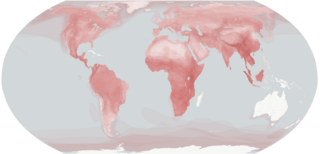
Carnivora is an order of placental mammals that have specialized in primarily eating flesh, whose members are formally referred to as carnivorans. The order Carnivora is the fifth largest order of mammals, comprising at least 279 species.

Felidae is the family of mammals in the order Carnivora colloquially referred to as cats. A member of this family is also called a felid. The term "cat" refers both to felids in general and specifically to the domestic cat.

Viverridae is a family of small to medium-sized, feliform mammals. The viverrids comprise 33 species placed in 14 genera. This family was named and first described by John Edward Gray in 1821. Viverrids occur all over Africa, southern Europe, and South and Southeast Asia, across the Wallace Line.
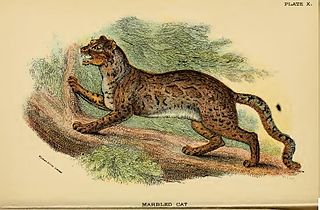
Pardofelis is a genus of the cat family Felidae. This genus is defined as including one species native to Southeast Asia: the marbled cat. Two other species, formerly classified to this genus, now belong to the genus Catopuma.

The spotted linsang is a linsang, a tree-dwelling carnivorous mammal, native to much of Southeast Asia. It is widely, though usually sparsely, recorded, and listed as Least Concern on the IUCN Red List.
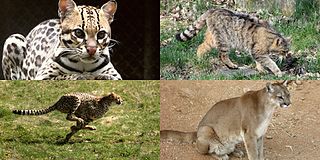
Felinae is a subfamily of the Felidae and comprises the small cats having a bony hyoid, because of which they are able to purr but not roar. Other authors have proposed an alternative definition for this subfamily, as comprising only the living conical-toothed cat genera with two tribes, the Felini and Pantherini, and excluding the extinct sabre-toothed Machairodontinae.

A genet is a member of the genus Genetta, which consists of 17 species of small African carnivorans. The common genet is the only genet present in Europe and occurs in the Iberian Peninsula, Italy and France.
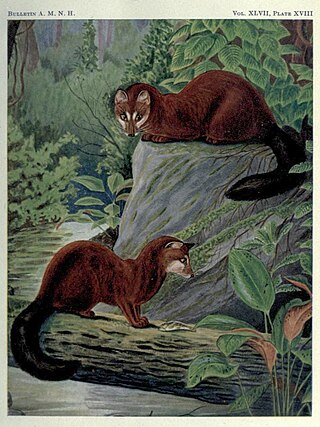
The aquatic genet, also known as the fishing genet, is a genet that has only been recorded in the northeast of the Democratic Republic of the Congo. Since it is only known from about 30 specimens in zoological collections, it had been listed as Data Deficient on the IUCN Red List since 1996, as it is considered one of Africa's rarest carnivores. In 2015, it has been reassessed as Near Threatened.
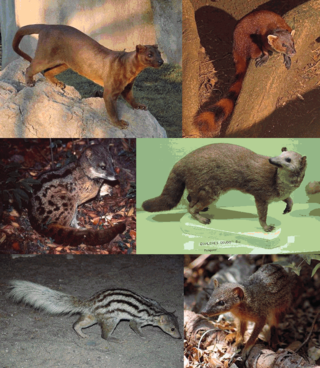
Eupleridae is a family of carnivorans endemic to Madagascar and comprising 10 known living species in seven genera, commonly known as euplerids, Malagasy mongooses or Malagasy carnivorans. The best known species is the fossa, in the subfamily Euplerinae. All species of Euplerinae were formerly classified as viverrids, while all species in the subfamily Galidiinae were classified as herpestids.

The rusty-spotted genet, also called panther genet and large-spotted genet, is a genet that is widely distributed in sub-Saharan Africa. It is considered common and therefore listed as Least Concern on the IUCN Red List.

The banded linsang is a linsang, a tree-dwelling carnivorous mammal native to the Sundaic region of Southeast Asia.
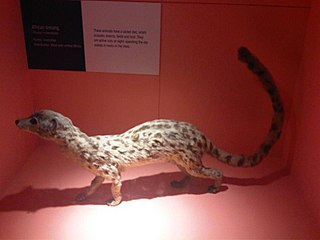
The Central African oyan, also called Central African linsang, is a linsang species native to Central Africa.

Feliformia is a suborder within the order Carnivora consisting of "cat-like" carnivorans, including cats, hyenas, mongooses, viverrids, and related taxa. Feliformia stands in contrast to the other suborder of Carnivora, Caniformia.

The Viverrinae represent the largest subfamily of the Viverridae comprising three genera, which are subdivided into six species native to Africa and Southeast Asia. This subfamily was denominated and first described by John Edward Gray in 1864.

Bourlon's genet is a genet species native to the Upper Guinean forests. It is known from only 29 zoological specimens in natural history museum and has been described as a new Genetta species in 2003. It is listed as Vulnerable on the IUCN Red List as the global population is estimated at less than 10,000 mature individuals.

The African linsangs also known as oyans are two species classified in the mammalian subfamily Viverrinae, in the family Viverridae. There is one genus, Poiana.

The linsangs are four species of tree-dwelling carnivorous mammals. The name of these species originated in the Javanese language as linsang or wlinsang, and previously, was translated incorrectly in English dictionaries as "otter". The two African species belong to the family Viverridae and the two Asiatic species belong to the family Prionodontidae. Formerly, both linsang genera were placed in the subfamily Viverrinae, along with several other genera, but recent research suggests that their relationships may be somewhat different.

Asiavorator is an extinct genus of civet-like carnivoran belonging in the family Stenoplesictidae. It was endemic to Asia and lived during the Eocene and Oligocene epochs.

Genettinae is a subfamily of the feliform viverrids. It contains all of the genet species and the oyan species.



















